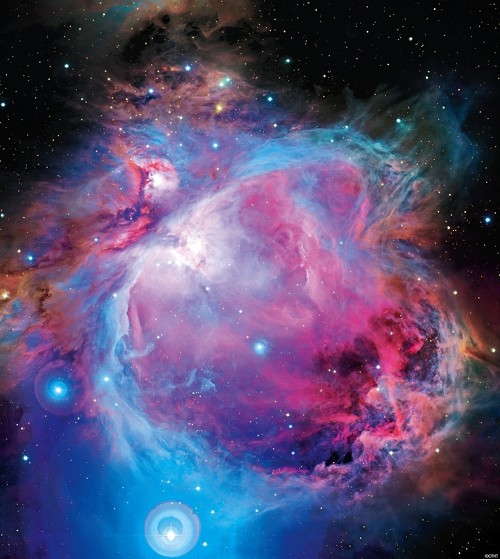We're open daily! View holiday hours
Science News
Universe Update, November 2012
November 27, 2012
by Dan Brady

The third Thursday of every month, give or take, Morrison Planetarium hosts “Universe Update” at the 6:30 planetarium shows during NightLife. We select our favorite astronomy stories from the past month, and give a brief run-down of current discoveries while taking audiences on a guided tour of the Universe.
We always start at Earth and work our way out to cosmological distances, and we’ll list the news stories in the same order—from closest to farthest from home.
Let’s start at Mars. Curiosity, the latest addition to our growing team of Martian rovers, landed on the Red Planet just a few months ago. Previous landers sent back pictures and performed basic measurements, but Curiosity brought an entire geology and chemistry lab on a 225-million-kilometer expedition to Gale Crater, where the rover is using its instruments to search for evidence of Mars’s past.
In its “rocknest,” Curiosity found wind-swept dunes containing material similar to volcanic soil in Hawaii. After vaporizing samples with its onboard laser, Curiosity’s CheMin instrument then used X-ray diffraction to search for clues to understanding the history of Mars’s atmosphere. Evidence suggests that Mars once had a much thicker atmosphere, which disappeared a long time ago, leaving the thin layer we observe today. As previous landers found layers of frozen water beneath Mars’s surface, Curiosity is taking the next step, equipped to hunt for methane, an organic molecule that’s a good indicator of life. So far, Gale Crater seems devoid of this malodorous precursor, but Curiosity has two years and many kilometers of Martian soil to cover.
Our next stop is the giant asteroid Vesta: over 500 kilometers in diameter (the distance from San Francisco to Los Angeles), it’s the second-largest asteroid in our solar system. The Dawn mission photographed it for over a year, looking at Vesta as a good example of what Earth may have looked like when it was just a wee baby protoplanet. The big differences between light and dark in these photos puzzled scientists, since asteroid terrain isn’t usually so varied. Space weathering should homogenize the surface, leaving a matte gray all over the surface. But scientists now think that the dark material comes not from Vesta but from 300 smaller asteroid impacts over the last 3.5 billion years, each of which brought material such as the metallic dust, carbon, and hydrated minerals (minerals containing water) Dawn detected. This mélange can account for the difference in light and dark areas, wrapping Vesta in powdered asteroid debris, one-to-two meters thick.
With a constant influx of data, astronomers are discovering new exoplanets faster than ever. Re-examining old data can produce useful results, too, and astronomers have just announced that a planet somewhere between Earth- and Neptune-sized is orbiting HD 40307. Despite only being three quarters as massive as our Sun, this star hosts six planets in total. Most importantly, the new planet is orbiting right in that habitable sweet spot: not too cold and not too hot, this is a strong contender to have liquid water, that necessary ingredient for life on Earth (and very possibly elsewhere).
Our view of the stars from Earth is strictly two-dimensional, and even with visualizations like the planetarium’s Digital Universe, we still rely on our Earth-bound view to determine distances to objects in space. A new image (see above) from a 340-megapixel camera on a telescope in Hawaii has found a heretofore unidentified cluster of stars in the familiar Orion constellation. The most studied part of our night sky, the Orion Nebula turns out to have many layers, and the stars we see in the middle are in fact older stars closer to us than we previously suspected.
Two twelve-billion-year-old supernovae live far, far from our starting point on Earth: because looking out into space also means looking back in time, the Universe has changed a lot since these stars exploded, so it’s hard to give you a distance in kilometers or even lightyears, but one of them holds the record as the most distant supernova yet observed. Needless to say, these are very, very old explosions that came from even older, supermassive stars, the likes of which don’t exist in the nearby, more recent Universe.
As the Universe continues to accelerate outward, the light we can see here on Earth fades into the cosmos. In a few billion years, information from these distant galaxies simply won’t make it to Earth anymore, and we’ll be living in a rather empty neighborhood. The parallels with the economic downturn are a little alarming, and a press release from a group of European cosmologists hammers it home. It turns out that stars in the Universe are only forming at 1/30 the rate they once were: a cosmic market crash that looks to continue till the end of time. The Universe seemed to peak about 11 billion years ago… Let’s hope the same isn’t true for the American GDP!
Dan Brady is a planetarium presenter at the California Academy of Sciences. He earned his BS in Physics from UCLA and has taught science since 2008.
Image: CFHT/Coelum (J.-C. Cuillandre & G. Anselmi)